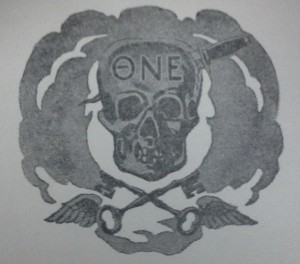Rigged Elections: The Story of Theta Nu Epsilon

Since making their first appearance on campus in 1900, Greek life in the form of fraternities and sororities has been an integral part of the University of Oregon community. One of the principal tenets of Greek life, however, is specific affiliation with one fraternity or sorority. This did not preclude membership in clubs and honor societies, but Hellenic societies have long been rooted in specified membership and being anchored to just one fraternity or community.
In that context, the rise of Theta Nu Epsilon as a sub rosa interfraternity organization between the 1930s and the 1950s was anathema to the spirit of Greek life. Theta Nu Epsilon developed outside the fraternal infrastructure, incorporating members from each fraternity on campus in order to form a cabal that controlled student government and student life behind the scenes. This article takes a brief look at the organization and its illicit history on the University of Oregon campus.
Theta Nu Epsilon originally formed as an offshoot of Yale’s Skull and Bones society at Wesleyan University in 1870. Two years later, the sophomore class society disaffiliated from Skull and Bones, forming as an independent entity and beginning to organize new chapters on other campuses. By 1907, after three and a half decades of growth, the interfraternity group laid the groundwork for a national organization.
Suspicions about TNE’s existence in Eugene were arising as early as the 1920s. A 1922 editorial in the Oregon Daily Emerald, which was then republished in the Stanford Daily and other campus newspapers, discussed the relation between the sub rosa fraternity and mounting Ku Klux Klan recruitment in Oregon. In the article it alludes to an even earlier history of TNE activity on campus, arguing that “administrative authorities will in the end meet the same problems [with the KKK] which they did in combating Theta Nu Epsilon, in the olden days.”
In 1936, the first concrete accusations about the existence of a secret Theta Nu Epsilon chapter on the University of Oregon campus started to come to light. That April, 26 students signed notarized affidavits that read as follows:
I, [student], make the following declaration: That I was an active member of the sub rosa organization on the campus known as T.N.E.; that said organization has been dissolved on the University of Oregon campus; that I am no longer a member of T.N.E.; and that I will not hold membership in this organization in the future.
In response, the national organizations affiliated with fraternities operating legitimately on campus wired messages to UO denouncing Theta Nu Epsilon. In these telegrams, eight fraternities — Sigma Phi Epsilon, Delta Tau Delta, Alpha Tau Omega, Phi Delta Theta, Theta Chi, Sigma Nu, Sigma Chi, and Phi Gamma Delta — articulated the position that members risked expulsion from their organizations by affiliating with sub rosa societies.
During this period of university growth in the United States, Oregon was not unique in combating underground fraternal organization on its campus. Montana State University in Missoula was forced to confront the existence of a TNE chapter on its campus when police riot squads were forced to break up a riot at a political rally on campus; the rally was directly related to a student group working to abolish Theta Nu Epsilon and another secret society, Kappa Beta Phi, on its campus. The University of Missouri had its own confrontation with the group in 1940 after the death of a student during a TNE initiation ceremony. In both this and other instances, the TNE chapter was not officially affiliated with the university and acted as a rogue operator on campus.
The Oregon Daily Emerald, after years of investigation, finally blew the cover off the underground campus political organization with a full expose in its November 7, 1946 issue. In the issue, which followed on recent nationwide coverage of the Theta Nu Epsilon chapter at the University of Southern California, the editors and reporting staff detailed the allegations of political intrigue that had continued to be manifested by the TNE leadership.
The expose led to a major internal investigation by the UO administration. Over three years of digging eventually led to the revelation that at least 26 fraternity members were simultaneously involved with Theta Nu Epsilon in violation of both university and fraternity policies. A new affidavit was drafted and signed in 1950 by the 26 students, which read thusly:
I, the undersigned student at the University of Oregon, Eugene, Oregon, admitting freely and without coercion of any nature, that I have been an active member of the local chapter of Theta Nu Epsilon, illegal secret fraternity, attest to the following statement:
1. I recognize that TNE is contrary to the basic principles of American democracy in its conception and in its procedures, and that it is inimical to the best interest of the University of Oregon and its student body;
2. I hereby renounce the organization from this time forward, stating categorically that I have withdrawn from membership, that I have given the University authorities all of the information which I have relating to this organization, its operation on the University campus, and its procedural base. Furthermore, I have turned over to the University authorities all evidence I possess of my personal membership and of the chapter operations;
3. I agree that I will not affiliate again with this organization or any other secret and illegal society while a member of the University of Oregon student body; that I will exert my efforts in every possible manner to prevent the development of such activities on this campus at any time in the future; and that substantial evidence of activity on my part to support, encourage, or in any other way to participate in the organization or activities of any secret and illegal society while a student at this University shall be cause for immediate and unconditional expulsion from the institution.
Over the next decade, further allegations would surface about TNE and the organization’s continued involvement in campus politics, though by the mid-1950s the presence of the sub rosa interfraternity political group had effectively disappeared from the University of Oregon. While voting blocs remain a reality, the political machine operating in the shadows that was represented by Theta Nu Epsilon ceased to function.
Information for this article was collected from the following sources:
- Theta Nu Epsilon, University of Oregon chapter records, UA 135, Special Collections & University Archives, University of Oregon Libraries, Eugene, Oregon.
- Oregon Daily Emerald (Eugene), November 7, 1946.
Zach Bigalke
Student Research Assistant

